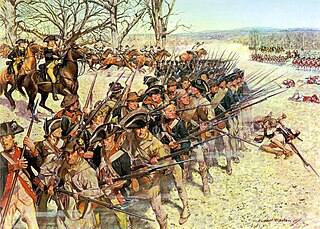
The Battle of Guilford Court House was on March 15, 1781, during the American Revolutionary War, at a site that is now in Greensboro, the seat of Guilford County, North Carolina. A 2,100-man British force under the command of Lieutenant General Charles Cornwallis defeated Major General Nathanael Greene's 4,500 Americans. The British Army, however, suffered considerable casualties.
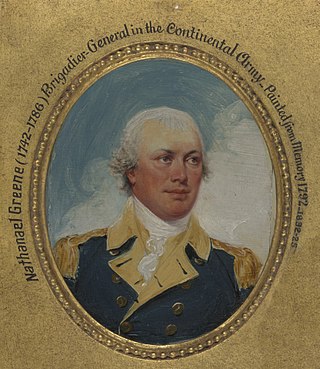
Major-General Nathanael Greene was an American military officer and planter who served in the Continental Army during the Revolutionary War. He emerged from the war with a reputation as one of George Washington's most talented and dependable officers, and is known for his successful command in the Southern theater of the conflict.

The Battle of Camden, also known as the Battle of Camden Court House, was a major victory for the British in the Southern theater of the American Revolutionary War. On August 16, 1780, British forces under Lieutenant General Charles, Lord Cornwallis routed the numerically superior American forces led by Major General Horatio Gates about four miles north of Camden, South Carolina, thus strengthening the British hold on the Carolinas following the capture of Charleston.
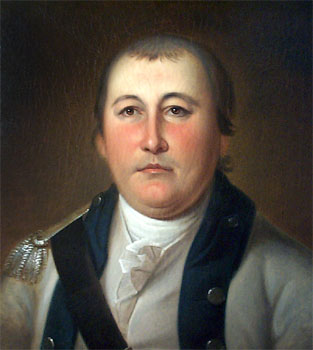
William Washington was a cavalry officer of the Continental Army during the American Revolutionary War, who held a final rank of brigadier general in the newly created United States after the war. Primarily known as a commander of light dragoons, he led mounted troops in a number of notable battles in the Carolinas during the campaigns of 1780 and 1781.
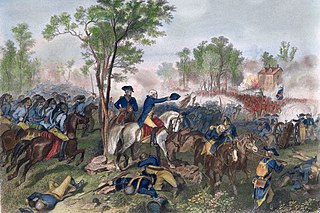
The Battle of Eutaw Springs was a battle of the American Revolutionary War, and was the last major engagement of the war in the Carolinas. Both sides claimed a victory.

Francis Edward Rawdon-Hastings, 1st Marquess of Hastings,, styled The Honourable Francis Rawdon from birth until 1762, Lord Rawdon between 1762 and 1783, The Lord Rawdon from 1783 to 1793 and The Earl of Moira between 1793 and 1816, was an Anglo-Irish politician and military officer who served as Governor-General of India from 1813 to 1823. He had also served with British forces for years during the American Revolutionary War and in 1794 during the War of the First Coalition. In Ireland, he was critical of the policy of coercion used to break the United Irish movement for representative government and national independence. He took the additional surname "Hastings" in 1790 in compliance with the will of his maternal uncle, Francis Hastings, 10th Earl of Huntingdon.

Edward Carrington was an American soldier and statesman from Virginia. During the American Revolutionary War he became a lieutenant colonel of artillery in the Continental Army. He distinguished himself as quartermaster general in General Nathanael Greene’s southern campaign. He commanded artillery at Monmouth and Yorktown. He was also present at Cowpens, Guilford Court House, and Hobkirk's Hill. During the war he became a close friend of George Washington. Carrington served in the 3rd Continental Congress and was the first US Marshal appointed from his state. He was an original member of the Society of the Cincinnati.

The Battle of Cowpens was an engagement during the American Revolutionary War fought on January 17, 1781 near the town of Cowpens, South Carolina, between American Patriot forces under Brigadier General Daniel Morgan and British forces, nearly half American Loyalists, under Lieutenant Colonel Banastre Tarleton, as part of the campaign in the Carolinas. The battle was a turning point in the American reconquest of South Carolina from the British.

The Battle of Waxhaws was a military engagement which took place on May 29, 1780 during the American Revolutionary War between a Patriot force led by Abraham Buford and a British force led by Banastre Tarleton near Lancaster, South Carolina. Buford's men consisted of Continental Army soldiers, while Tarleton's force was mostly made up of Loyalist troops. After the two forces sighted each other, Buford rejected an initial demand to surrender. Tarleton's cavalrymen launched a charge against the Patriot troops, which led many of Buford's men to throw their arms down in surrender. However, as Tarleton was shot under his horse during the charge, his infuriated soldiers attacked their Patriot opponents, killing several.
The 2d Virginia Regiment was authorized by the Virginia Convention, July 17, 1775, as a force of regular troops for the Commonwealth's defense. It consisted of seven companies, 476 privates and the usual regimental officers. William Woodford, of Caroline County, named colonel, along with Lieutenant Colonel Charles Scott and Major Alexander Spotswood were the regiment's initial field officers. Virginia had been divided into 16 military districts which took their names from the predominant county in the grouping; for instance, Prince William District included Fairfax and Loudoun Counties as well. Col. Gregory Smith 1777-78 Col Brent 1779

The siege of Fort Motte was a military operation during the American Revolutionary War. A force of Patriots led by General Francis "Swamp Fox" Marion and Lt. Colonel "Light Horse" Harry Lee set out to capture the British post at Fort Motte, the informal name of a plantation mansion fortified by the British for use as a depot because of its strategic location at the confluence of the Congaree and Wateree rivers. The British garrisoned roughly 175 British soldiers under Lt. Daniel McPherson at the fort.

The southern theater of the American Revolutionary War was the central theater of military operations in the second half of the American Revolutionary War, 1778–1781. It encompassed engagements primarily in Virginia, Georgia, North Carolina, and South Carolina. Tactics consisted of both strategic battles and guerrilla warfare.

Griffith Rutherford was an American military officer in the Revolutionary War and the Cherokee-American Wars, a political leader in North Carolina, and an important figure in the early history of the Southwest Territory and the state of Tennessee.

The siege of Fort Watson was an American Revolutionary War confrontation in South Carolina that began on April 15, 1781 and lasted until April 23, 1781. Continental Army forces under Henry "Light Horse Harry" Lee and South Carolina militia under Francis Marion besieged Fort Watson, a fortified British outpost that formed part of the communication and supply chain between Charleston and other British outposts further inland.

The siege of Ninety Six was a siege in western South Carolina late in the American Revolutionary War. From May 22 to June 18, 1781, Continental Army Major General Nathanael Greene led 1,000 troops in a siege against the 550 Loyalists in the fortified village of Ninety Six, South Carolina. The 28-day siege centered on an earthen fortification known as a star fort. Despite having more troops, Greene was unsuccessful in taking the town, and was forced to lift the siege when Lord Rawdon approached from Charleston with British troops.
John Gunby was an American planter and soldier from Somerset County, Maryland, who is considered by many to be "one of the most gallant officers of the Maryland Line under Gen. Smallwood". He entered service volunteering as a minuteman in 1775 and fought for the American cause until the end earning praise as probably the most brilliant soldier whom Maryland contributed to the War of Independence. Gunby was also the grandfather of Senator Ephraim King Wilson II.

Otho Holland Williams was a Continental Army officer from Maryland in the American Revolutionary War. He participated in many battles throughout the war in the New York, New Jersey and Southern theaters, eventually ending his career as a brigadier general.
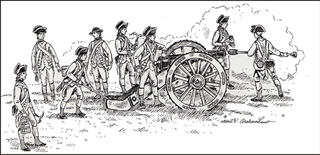
The 1st Continental Artillery Regiment, also known as Harrison's Continental Artillery Regiment, was authorized on 26 November 1776 as Colonel Charles Harrison's Continental Artillery Regiment. Raised for service during the American Revolutionary War, as originally organized, the regiment comprised 10 artillery companies from Virginia. Two of the artillery companies existed since early 1776. The regiment was first assigned to the Southern Department, but in March 1778 it was reassigned to General George Washington's main army. In August 1779, the unit was renamed the 1st Continental Artillery Regiment. It continued to serve with the main army until April 1780 when it was transferred to the Southern Department. In May 1780, Maryland artillery companies formally joined the regiment, making a total of 12 companies. In January 1781, the regiment was reorganized with 10 companies. Furloughed in the summer of 1783, the regiment was disbanded in November the same year. Elements of the regiment fought at Monmouth, Charleston, Camden, Hobkirk's Hill, Eutaw Springs, Yorktown, and Combahee River.
Charles Harrison was born into the noted Harrison family of Virginia. His brother was a signer of the Declaration of Independence and his nephew William Henry Harrison later became president. At the beginning of the American Revolutionary War he became lieutenant in a company of artillery from Virginia. When the state expanded its small artillery battalion into a regiment in November 1776, Harrison was appointed commander with the rank of colonel. Initially named Harrison's Continental Artillery Regiment, the unit was renamed the 1st Continental Artillery Regiment in August 1779. He joined George Washington's main army in time to fight at Monmouth. In 1780 he led his gunners at Camden and the following year he commanded Nathanael Greene's artillery at Hobkirk's Hill.
North Carolina state troops in the American Revolution were the initial military units created in a transition from the Province of North Carolina under British rule to independence from British rule. Most units did not last long as such and were either transferred to the Continental Army or state militia instead.

















